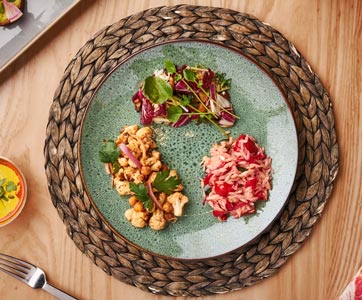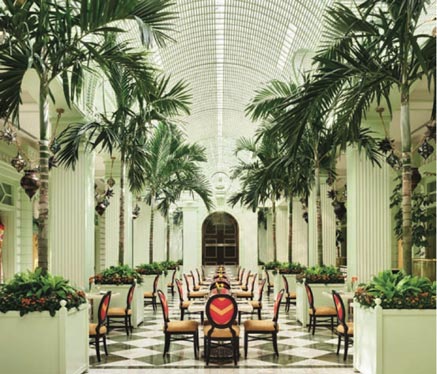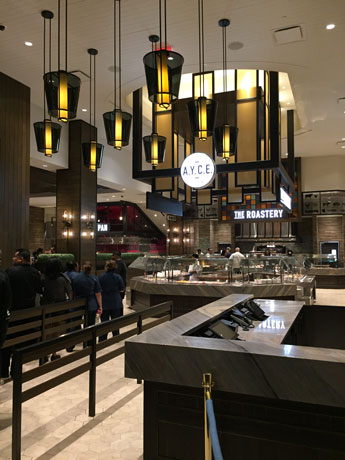
In ancient Roman mythology, Bacchus was the god of revelry, a hard-partying deity devoted to wine, food and merrymaking. The term “bacchanalia”—meaning the ultimate feast—was the inspiration for Bacchanal, a 25,000-square-foot eating extravaganza at Caesars Palace in Las Vegas. Starting in 2012, Bacchanal was a Sin City favorite until Covid-19 shut down the world, on and off the Strip.
Caesars made good use of the pause, completing a $2.4 million makeover. When the buffet reopened in 2021, it offered “new, elevated dishes” that “redefine the Las Vegas buffet experience,” says Terrence O’Donnell, Caesars Palace vice president and assistant general manager.
Along with the classic chow line, Bacchanal features roaming food carts and nine open kitchens. More and more, kitchens are part of the floor show, as guests witness the creativity of a culinary team at work.
Bacchanal “leans into the trend of unique dining experiences through its interactive kitchens,” notes O’Donnell, with “an up-close and personal view of what’s normally behind closed doors. The kitchens feature open-fire roasting grills for made-to-order dishes, along with steaming and refrigeration systems that provide the ideal atmosphere for market-fresh seafood.”

Vegan menu options at Bacchanal
Bacchanal is known for plated and made-to-order mini-dishes, along with American and Latin carving stations.
Original designer Tetsuo Aoyagi refined the space, which features glass and stone finishes “reminiscent of ice caves and mountains.”
It all goes to show that in some quarters, the casino buffet is alive and well—but evolving.
Changing Times & Tastes
Buffets have been a staple of casinos since the mid-1940s, when the first Strip casino, the El Rancho, introduced its aptly named Buckaroo Buffet. It charged a buck a head for a modest spread of cold cuts, salad and seafood.
For decades to follow, buffets were loss leaders designed to keep gamblers on-property, explains Brett Ewing, principal, Cuningham Group Architecture. “Different properties could determine to the dollar the economics, how much they made on the players. The baby boomer crowd really liked the buffet.”
In the 1980s and ’90s, buffets went super-size, and in the mid-2000s, “reached the height of their grandiosity, fitted out with really expensive materials,” says John Ruiz, principal and managing member of R2Architects. Buffets became entertainment, in keeping with the food-TV trend that started around the same time.
“In the dessert station, they’d be out there with a torch, bronzing the cream on the Bananas Foster,” he says. “These buffets were very luxuriously designed and beautifully appointed.”
 But big or small, buffets were never cost-efficient for operators; on average, about half of the food was left over and had to be discarded. Operators now are trying to reduce that ratio, not just to save money but in keeping with their sense of social responsibility. According to the U.S. Department of Agriculture, reducing food waste could not only help ease hunger but also mitigate the effects of landfill gases on the climate.
But big or small, buffets were never cost-efficient for operators; on average, about half of the food was left over and had to be discarded. Operators now are trying to reduce that ratio, not just to save money but in keeping with their sense of social responsibility. According to the U.S. Department of Agriculture, reducing food waste could not only help ease hunger but also mitigate the effects of landfill gases on the climate.
“We always hear from operators about the tremendous cost of operation—a significant food waste cost, labor costs across the entire spectrum of hospitality, and the footprint and capital to fit out the space, build it and maintain it,” says Ruiz. “It just becomes a really expensive operation.”
In addition, the original buffet concept—heaping helpings of crab legs and pasta, piled up under heat lamps—didn’t keep up with “the trend toward fast-casual freshness, and the big push for ethnic and global food,” says Natina James, senior associate with the Cuningham Group.
By some estimates, the pandemic shut down more than 40 buffets in Las Vegas alone; many tribal casinos in Southern California have dispensed with the concept, along with many properties around the country.
Ewing says the shift was overdue. The viral outbreak “accelerated a change that was ready to happen. It was the impetus to make changes that are now sweeping across the industry.”
 Mehmet Erdem, associate professor at the William F. Harrah College of Hospitality at the University of Nevada, Las Vegas, would likely agree. He recently told Nevada Public Radio, “Covid taught the industry (that) we need to do more with less and generate revenue more carefully. … Revenue techniques didn’t happen just after Covid, but Covid put it more in focus.”
Mehmet Erdem, associate professor at the William F. Harrah College of Hospitality at the University of Nevada, Las Vegas, would likely agree. He recently told Nevada Public Radio, “Covid taught the industry (that) we need to do more with less and generate revenue more carefully. … Revenue techniques didn’t happen just after Covid, but Covid put it more in focus.”
Yet those high-end buffets have endured. Along with Bacchanal, they include AYCE (All You Can Eat) at the Las Vegas Palms, owned by the San Manuel Band of Mission Indians; the Buffet at Bellagio, which returned in 2021 with live cooking and carving stations; and Wicked Spoon at Cosmopolitan, its culinary couture jazzed up by delicacies like squid-ink pasta and wild boar.
These aren’t the budget buffets of old, where guests could chow down for a couple of dollars. Some higher-end eateries—mostly a Vegas phenomenon—command up to $75 per head.
‘The New Buffet’
When the Buffet at Wynn reopened in the summer of 2021, Executive Chef Jason Duarte said the model had shifted to 60 percent self-serve and 40 percent plated, a departure from traditional buffet service but in keeping with greater health consciousness.
Some things at the buffet are different (the atrium is lined by royal palms, imported from Florida). Some things remain the same (Frank Sinatra’s recipe for spaghetti and meatballs is still on the menu). But diners are increasingly likely to find vegetarian and vegan options on the menu.
The buffet maintains its “garden party” look, complete with cherry-and-white striped awnings, bountiful flowers and foliage, and abundant natural light. Its nearly 24,000 square feet are grouped into smaller spaces for a clubby feel, which is enhanced by coffered ceilings, hanging lamps and chandeliers, and carved columns and archways.
“Our goal,” said Duarte, “is to make this as upscale as a fine-dining restaurant.”
Some buffets are transitioning to food halls, not to be confused with food courts, a mall staple that usually features fast-food chains. Food halls, by contrast, serve local, artisanal dining options and ethnic food.
These marketplaces have been called “the new buffet.” The largest food hall can span up to 40,000 square feet, according to Building Design & Construction, but less can be more. A 10,000-square-foot food hall, which can comfortably fit five food stalls, makes for a more intimate dining experience.
The concept isn’t new—the food hall trend originated in about 2010, and has been accelerating ever since—but big and small, they’re now cropping up in casinos everywhere, sometime in spaces formerly occupied by buffets. Take Proper Eats at Aria, once a buffet. Then there’s Famous Foods Street Eats at Resorts World, “inspired by the energetic street markets of Southeast Asia.”
In Downtown Las Vegas, the Fremont Hotel and Casino just opened an eponymous food hall. Station Casinos is next, with the Eat Your Heart Out Hall of Foods, set to debut this fall at the Durango. That 25,000-square-foot open space will feature multiple “storefronts” serving Hawaiian food, Asian noodles and sushi, New York pizza and more.
“The food hall is the big concept now, with some of the same kinds of food offerings” that are a specialty of buffets, says David Rudzenski, R2A architect, planner and interior designer. “The fast-food hybrid seems to be the direction everyone is going.”
In the post-Covid age, buffets have dispensed with many pre-made foods, along with shared utensils and back-to-back lines. Some now require diners to make reservations or join an OpenTable waitlist.
Kitchen operations that are visible to diners are a reassuring sign of freshness, says James. “When food is cooked and prepared in front of you, it gives people some confidence that the food is fresh and not sitting out in a warming tray.”
Ewing agrees. “I recently visited a waffle shop in Texas, and thought, ‘What are we stepping into here?’ But when I saw the kitchen was exposed, I felt better, because I could see what they were preparing.”
Open kitchens come with pros and cons—on the plus side, there’s increased transparency and a chance for the culinary team to showcase its artistry. But strong smells, the clang of pots and pans, and heat from the grills can be negatives. Needless to add, that hard-working staff must always be upbeat and “on.”
“The concept requires elevated staff procedures to keep things clean,” says James. That may mean special training to develop a more disciplined team. Warning: expect any slip-ups to be documented and posted online.
Meanwhile, higher-end buffets have appropriated a white-tablecloth practice: the chef’s table, positioned near or even inside the kitchen, where foodies can interact with and be personally served by the chef. In Las Vegas, these exclusive tables can be found at Bellagio, the Mirage and Caesars Palace.
Success on the Menu
Before investing millions to upgrade Bacchanal, Caesars executives had to be satisfied that the buffet as an F&B concept would outlast the pandemic. Asked who made that executive decision, O’Donnell says, “It really comes down to listening to our guests.
“We recognized we had a prime opportunity to enhance the space and make improvements for an even better gourmet buffet experience. After we reopened, we were excited to welcome back our guests and introduce them to a beautiful new restaurant as well as an expanded menu.”

AYCE Buffet at the Palms
While some have sounded the death knell for bargain buffets, a few have survived the upheaval of Covid and are doing just fine. In a 2022 interview with CBS News, Michael Kennedy, director of food operations at the South Point Casino on the Strip, described that property’s Garden Buffet as “a loss leader,” just like the buffets of the past. The colorful eatery offers a $9.95 breakfast with bottomless Bloody Marys as well as six cooking stations with Asian, Mexican, Italian and Chinese food, plus seafood, barbecue and the Mongolian Grill.
“We’re here to draw guests into our casino,” said Kennedy, “and it certainly works.”
Ewing, who has spent much of his career in Las Vegas, recalls a time when 80 percent of casino revenues were derived from gaming and just 20 percent from dining and entertainment. “Now gaming accounts for 40 percent,” he says, and hotel rooms, food and beverage and other spending on property makes up the rest.
Dining is more important to the bottom line. It also presents bigger challenges. But the well-curated buffet is still a valid part of the mix.
“I want to see owners realizing that food is an attraction,” adds James, “one that can be equivalent to the gaming area.”
Restaurants By Design
Many elements combine to create a memorable dining experience. Color, light, acoustics, art, furnishings and layout “all work well together depending on the restaurant type and how many turnovers you want,” says Cuningham’s Brett Ewing.
In design, there are no hard and fast rules, and style trends are always in flux. That said, the following precepts have stood the test of time:
- Design for optimal lighting. The wrong lighting can make the most beautiful restaurant seem indefinably “off.” Use a trifecta of light sources: ambient (general lighting); task (concentrated lighting, for tabletops, pathways and menu-reading); and accent (to highlight focal points, like art).In general, warm lights make a space feel more intimate and comfortable, while cool lighting lends a more spacious look. Bright lights may shorten the time spent dining, while dimmer lighting makes for a longer stay. Per Ewing, “The first question I ask an operator is, ‘Do you have the budget for a dimming system?’ This is always key.”
- Use a warm color palette. A study by the Rochester Institute of Technology suggests that shades of blue have a calming effect, but also decrease appetite (this color spectrum is ideal for the pool or spa). Red and yellow tones increase appetite and produce quicker turnarounds (but by all means, be sure to avoid the Wendy’s fast-food look).And beware of greens, which can have “a graying effect” on both food and people, says Ruiz. Warmer tones are more relaxing, and pinkish undertones flatter most complexions. Natural finishes and greenery along with natural light provide a nice balance of comfort and color.Color also affects space perception. Deeper shades can make a space look cozier.
- Be mindful of spacing, and adjust as needed. A crowded room can reduce intimacy, while wide-open spaces can make dinner guests feel exposed or on stage. Empty tables make any dining established look underutilized, so include smaller rooms or alcoves in the layout, or use dividers to close off parts of a restaurant when it’s not busy. “You want that balance,” says Ewing. “If a restaurant is empty, people think it’s not successful.”Placing tables and chairs in the center of the dining room, away from corners and walls, will encourage customers to eat more quickly. Patrons tend to linger if they’re seated on furniture that’s fixed and unmoving, like booths.And even in a buffet, says Cuningham Group’s Natina James, “You don’t want it to feel like a cafeteria.”
- Use seating to drive turnover. Looking to turn tables quickly? Backless metal bar stools will do the trick. Want guests to stay a while? Install plush restaurant booths and comfortable upholstered or wooden chairs. All furnishings should be “durable, have longevity and be relatively low-maintenance,” says R2A architect David Rudzenski.
- Be mindful of acoustics.Noisy restaurants are uncomfortable for some diners. Unless it’s a bar, keep the decibels down, and don’t place speakers near tables. People have to be able to carry on a conversation.

Wicked Spoon at Cosmopolitan





